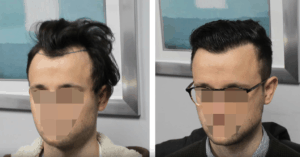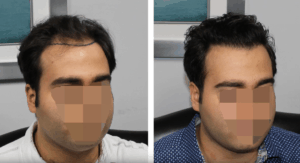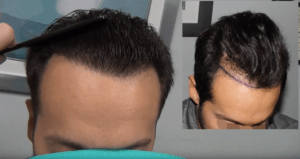Young Hair Transplant?
Can young patients undergo hair transplant surgery? Should young patients undergo hair transplant surgery? Should they consider something else first? What does that even mean anyway: “young patient?”
“Young Patient?” What does that even mean?

2,400 graft FUT performed on a patient in his early 20’s.
Different clinics have varying opinions; some believe any patient under the age of 25 is “young,” but most believe “young” patients are typically individuals in their early 20’s. Male pattern hair loss, or androgenic alopecia, frequently begins as early as the late teens. It is obviously quite jarring when an individual this young begins to experience a condition commonly, and mistakenly, associated with “old age,” and this is why so many young patients seek hair restoration consultations. Many patients also begin to see their hair loss “set off” by stress associated with college — though it is important to understand that stress does not necessarily cause hair loss, but it can “unmask” and accelerate genetic male pattern hair loss. These patients thin throughout their college years, and see a good opportunity to restore their hair before starting graduate school, their new career, or some other next “phase” of life. We typically believe these patients, early 20’s and somewhere in the college years, are “young” patients.
Can these patients undergo hair transplant surgery?
Can these patients undergo hair restoration surgery? Absolutely they can. Young patients in their early 20’s are typically in excellent physical shape, heal quickly, and are, therefore, ideal candidates for any type of surgery — elective or mandatory. These patients tend to heal quickly, grow very well, and transition back to “normal life” effortlessly after a hair transplant procedure. But just because someone “can” do something, does not necessarily mean they “should” do something, right?
Should “young” patients undergo hair restoration surgery?

Conservative 2,000 graft hairline rebuild on college-aged patient
Young patients do make excellent candidates and tend to do very well with hair transplant surgery. However, it is important to note that young patients, and their doctors, must approach hair transplant surgery in a slightly different manner. Androgenic alopecia is a progressive condition, and hair transplantation is a static solution. This means hair transplant surgery can replace hair that has already been lost, but it does not prevent hair from thinning and “falling out” in other regions. Patients also have a finite amount of donor hair to use for surgery. Not to mention the fact that hair transplants are also permanent. Hairlines created for patients in their early 20’s must still look natural in their 70’s, 80’s, and 90’s. Because of this, hair transplant surgery in young patients must be approached like a long-term, strategic game of chess. The doctor and patient must take a conservative approach to the hairline. A low, flat hairline may sound like a great idea to a 20 year old who still remember their “high school hairline,” but it will not likely “age well” and may require the use of too many grafts to maintain. The patient will likely wind up using most of the available donor region to restore the front and run out of grafts for the middle and back (crown) regions. Speaking of the donor region, young patients must use their donor area wisely. Lifetime donor grafts must be maximized, which means young patients must start with the FUT (follicular unit transplant or “strip”) technique. Starting with FUT allows patients to transplant the most grafts over the greatest number of procedures, and then allows FUE (follicular unit excision) to be utilized for regions which cannot be reached by strip surgery. Young patients must also understand and accept that they will most likely require multiple surgeries — as their hair loss continues to progress behind the previously transplanted regions. If the patient understands the long-term and strategic approach that must be taken in young individuals and commit themselves to a conservative hairline, FUT harvests, and multiple surgeries, there is no reason why they should not undergo hair transplant surgery.
But should they consider something “else” first?
Many young patients are encouraged to try preventive hair loss medications like Propecia (finasteride) and Rogaine (minoxidil) before undergoing hair transplant surgery. While starting slow and “testing the waters” before surgery is never a bad idea, there are a few things to consider here: First, keep in mind that medications and surgery are not mutually exclusive. Many patients take medications AND undergo hair restoration surgery. The medications will help slow the loss and maintain the hair in actively thinning regions and the transplant will restore the hair in areas where is has actually been “lost.” It is important to remember, however, that preventive medications are limited. While some patients respond well and they are designed for young patients who still have a lot of hair to “maintain,” many patients find medications alone insufficient. These medications do not stop hair loss or regrow hair, but only slow — and slow temporarily — the progressive process.

2,300 graft FUT on young patient.
This is why patients typically like to combine medications with surgery. By combining both, patients get the “best of both worlds.” These medications also do have potential side effects, and must be researched and discussed with a trusted personal physician before use by any patient — young or “old.” No other “preventive” hair loss treatments have been reviewed and proved safe and effective by regulatory agencies. Despite claims aimed at young, vulnerable patients, things like “laser” therapy, “PRP” injections, and scores of other vitamins, lotions, and potions are unproven and should be approached with skepticism.
So, can young patients undergo hair transplant surgery? Yes, they can. However, they must understand the intricacies of undergoing surgery early, proceed in a conservative and long-term manner, prepare themselves for the potential of multiple procedures, and consider maintaining as much native hair as possible.
Dr. Blake Bloxham
Feller & Bloxham Medical, PC






